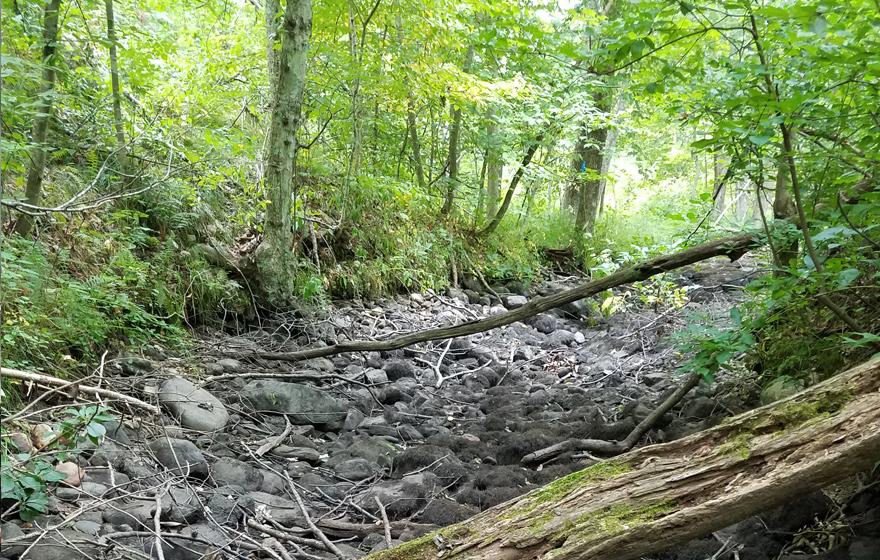- Division of Fisheries and Wildlife
Media Contact
Media Contact, MassWildlife

MassWildlife has received questions about how fish and wildlife may be responding to current drought conditions. It’s important to remember that fish and wildlife in New England have adapted to fluctuations in weather conditions, including harsh winters and droughts. That said, extended drought conditions can have the most direct and severe impacts on fish communities and fish habitats. Below are a few examples of impacts drought can have on some fish and wildlife.
Stream fishes suffer from reduced quantity and quality of habitat as reduced surface and groundwater flow squeeze them into ever-decreasing and isolated pools of water. Decreases in the amount of cold groundwater can change the quality of those remaining pools of water, which can have dramatic impacts on trout and other fishes. Stagnant water heats up fast in the summer resulting in a loss of dissolved oxygen required to keep fish alive. As fish become trapped in smaller pools, they also become easy targets for a host of predators ranging from herons and raccoons to larger fish in the same pool. There is also increased likelihood for disease outbreaks and lower reproductive success for fishes during drought. Some very small streams can dry out entirely. In these extreme cases, it can take months or years for fish to recolonize the impacted reaches. As a drought increases in severity and duration, the impacts that are felt in headwater streams get transferred to larger systems and impact fish communities on an ever-widening scale.
MassWildlife monitors fish communities to gain a better understanding of the effects of drought in a human-dominated landscape. Currently, MassWildlife is collaborating with USGS to study changing streamflow patterns and warming temperatures in streams across the state. The goal of this project is to identify areas, called climate change refugia, that are least likely to change in the coming decades.
Lake and pond fishes are generally less impacted by drought than those living in streams, but prolonged drought can have impacts. Very shallow ponds that are heavily vegetated encounter large swings in dissolved oxygen levels. Water’s ability to hold oxygen decreases as water temperatures rise. This is compounded when, at night, aquatic plants start to consume oxygen. As drought lowers water levels in already shallow ponds, these oxygen level fluctuations get more severe and can result in fish kills.
Whether in lakes, ponds, streams, or rivers, anyone who witnesses a fish kill caused by any reason should report it to the Massachusetts Environmental Police’s 24-hour radio room at 1-800 632-8075.
Trout stocking this fall may be impacted by the drought, although it is too early to know. Drought in the Northeast is difficult to predict since, unlike Western states, we don’t have a snowpack in the high mountains to monitor. Long-range rainfall forecasts are difficult to make, so variables like streamflow and groundwater levels are some of our best ways to monitor drought. Trout stocking typically begins in mid-September, depending on temperature. Curtailment of some trout stocking in rivers and streams this fall may occur due to low flows, but few impacts on lake and pond stocking are expected. MassWildlife fisheries biologists will assess the condition (temperature, flow, etc.) of each waterbody before making a final decision about stocking.
Bears rely on summer berries, which can be diminished with extended drought. As a result, bears search for other types of food causing them to visit residential areas more often than in a normal year. In dry summers, nuisance bear complaints tend to be higher because bears are more frequently using residential areas, taking advantage of bird feeders and trash. Dry summer conditions can also affect the timing and quality of fall acorn crops, an important fall food source for bears. This can cause bears to seek food in agricultural areas and can lead to crop damage.
Deer likely experience few direct impacts from the drought, as deer browse on a variety of food sources. Extreme dry conditions can cause deer to congregate in areas where food and water is more readily available. Setting up water drinking sites for deer is strongly discouraged because the artificial concentration of deer over small bodies of water increases the risk for disease transmission between deer.
Moose also browse on a variety of food sources, but are more likely to experience stress during hot, dry conditions. Moose seek shelter from hot temperatures in forested wetlands and use mud and shallow water to cool down. When these wetland areas begin to dry up during drought, moose can struggle to find relief from the heat.
Waterfowl like ducks, geese, and swans can fly to waterbodies with adequate water levels when needed.
Turkeys likely suffer few negative impacts. In general, turkey populations are more sensitive to spring weather conditions and nest predators.
Beaver have the ability to regulate water levels, so if water becomes too shallow they may increase dam building activity. If they cannot raise the water level through additional damming, beavers may leave the wetland in search of deeper water.
Learn more about drought conditions and actions you can take to conserve water.
Stream image courtesy of Theodore Beauvais.
